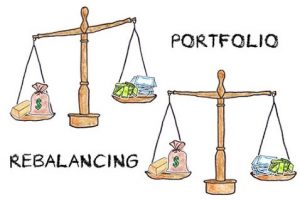2022 – 5 STEPS FOR YEAR END PORTFOLIO REBALANCING
As 2022 is nearing year end, now may be an ideal time for investors to review their portfolio investments, making necessary rebalancing changes.

Rebalancing is the process of reallocating assets within a portfolio. It is a method to help you get your investments back in line with your target allocation of stocks, bonds and short-term reserves. Rebalancing helps investors by shifting money from those investments that have performed well into portfolio underachievers.
Rebalancing is important since asset allocation is the major determinant of portfolio return. Furthermore, rebalancing can help control risk. Appropriate allocation targets can preserve / grow wealth for a desired level of riskiness, while helping investors to ‘buy low, sell high.” Periodic rebalancing keeps the investor on track.
Listed here are 5 steps to accomplish rebalancing.
Step 1: Determine your asset allocation targets:
What allocation of stock/bond/cash is right for you? Not sure? Consider reviewing the asset allocation of target-date mutual funds geared towards individuals in your age group. Such information is widely available on web sites, such as Morningstar, Vanguard and Fidelity. You’ll likely also find questionnaires that you can complete for insight to the allocation targets that are commensurate with your risk tolerance and growth needs.
Step 2: Determine your current asset allocation:
Organize investment statements so you can determine your current allocations. Do you understand the composition of your mutual funds and exchange traded funds, and how do these overlap with any individual stock holdings? Review your holdings closely to identify how you are currently allocated by asset type, sector and size.
Step 3: Review your individual holdings:
Use available research tools to review/analyze current holdings to spot early warnings signs. Examine performance, short and long term results. Which of your holdings are having the biggest impact on your portfolio performance? Always be sure to think about the tax consequences of any sell decisions while rebalancing, and to collectively consider other portfolios you may be managing.
Step 4: Implement your rebalancing plan:
Identify where current allocations need trimming – shift/rebalance money from those asset types that have performed well and reinvest into your portfolio underachievers. Continually review allocation to stay in line with your target allocation of stocks, bonds and short-term reserves.
Step 5: Make it a habit to periodically rebalance your portfolios!
Set a schedule – 1 or 2x’s per year.
In summary, portfolio rebalancing helps reduce chances for disproportionate losses if over concentrated in one asset class. Proper allocation is a cornerstone of good portfolio management, and rebalancing helps investors to avoid portfolio ‘drift’, which is critical to your long-term investment success. Rebalancing helps investors to buy low and sell high, and is an important portfolio management task for reaching long-term goals.
Investment Account Manager is a Windows desk-top based software tool (since 1985) that provides investors with the tools necessary to accomplish this important 5-step portfolio management task.
A free 60 day demo version (no credit card required) is available on our website: Investment Account Manager